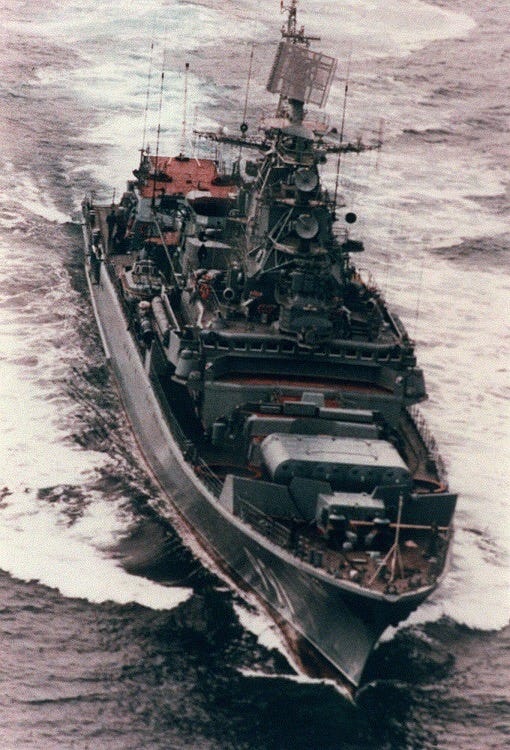The trial for a Soviet naval officer mutineer and the inspiration for Tom Clancy's Hunt for Red October, goes on trial in the Soviet Union. Like so many things in Hollywood and entertainment, the facts do not match up with the entertainment but that is why they call it fiction.
Soviet Captain 3rd Rank Valery Mikhailovich Sablin, a political officer aboard the Soviet Navy anti-submarine frigate Storozhevoy (Russian for Sentry or Guardian) led a mutiny aboard the ship because of his disillusionment with the Soviet system under Premier Leonid Brezhnev. Unlike the book and movie The Hunt for Red October and its officer led by the fictitious Marko Ramius and his intrepid officers, Captain Sablin was not looking for American freedom but was wanting more communism.
Captain Sablin had become disillusioned with the direction of the Soviet Union under Brezhnev and wanted to go back to the Soviet roots and practice of Leninism. He saw that the Soviet system under Brezhnev as being stagnated economically and of political vigor, corruption and hypocrisy and the establishment of a political elite class. Early in his career naval career, as a line officer, he supported Soviet Premier Khruschev and actually was audacious enough to write him a letter. He was also disturbed by the Brezhnev ordered violent crackdown in Prague in 1968. Sablin's issues with the Soviet Union seemed to be based on the leadership style of Brezhnev that appeared to be one of collective leadership which led to the establishment of a political class.
Despite his misgivings, Sablin was accepted into Lenin Military-Political Academy from 1969-1973 where he graduated with distinction, including his name carved in marble at the academy. Sablin moved from being a line officer to a political officer or zampolit. As a political officer he was considered the third in the line of command of a warship. Captain Sablin was assigned to the Storozhevoy in August 1973. Sablin's writings showed that he started planning the mutiny in 1975 and started recruiting accomplices. As the political officer, he was an influential officer aboard the ship.
On November 8, 1975 Captain Sablin lured the captain of the ship to a location on the ship where he locked him in a cabin and posted a guard outside. He was able to coax 8 of the 16 officers to support his call to sail to Leningrad to start a new revolution and restore Leninist principles to the Soviet Union. The officers who refused to join him were locked up but unharmed, and Sabin and his officers were able to convince the crew to go along with their orders. However, one officer who initially agreed to go along had a change of heart and escaped and was able to board a Soviet submarine and warn the captain of the mutiny aboard the Storozhevoy. Soviet officials were notified and ordered the sinking of the ship as it was sailing in the Baltic Sea heading toward Sweden once their plot started to fall apart.
Soviet aircraft were eventually able to damage the Storozhevoy, along with a Soviet freighter that was mistakenly bombed, and an apparent decision to fire an air launched nuclear missile that appears to have been ignored by the pilot who claimed a technical issue. Another aircraft was ordered to fire but this order was quickly rescinded by Soviet higher echelon authorities. The captain of the Storozhevoy was released by a crewmember and was shot in the leg and disarmed by the captain. Soviet authorities boarded the frigate and ended the mutiny officially ended on November 9, 1975.
Captain Sablin's was sent to the KGB's Lefortovo prison and was interrogated and beaten. His charges and motivation to mutiny caused consternation for Soviet authorities as he was able to justify his actions through his ready and thorough understanding of Marxist-Leninist doctrine to justify his actions which made it difficult for the KGB to reject without rejecting the claimed tenets of the Soviet Union. The Soviet authorities solved the issue by holding a secret trial staring on July 13, 1976 where Sabin entered a plea deal and pled guilty of treason and asked for leniency for the crew. The plea deal was accepted and Sabin was sentenced to death.
Sabin was executed in the basement of Lefortovo Prison on August 3,1976 with a single shot to the back of the head. The family was notified in February 1977 that he had died but did not state the cause or time of death.
If you would like to support my work in providing this content: Buy Me A Coffee









Very interesting, Thomas. Although I was serving in the Royal Navy at the time I knew nothing about this episode.